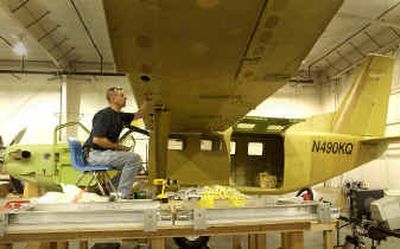An idea takes wing

SANDPOINT – More than 20 years ago, a pilot flying grain to starving refugees in the West African nation of Mali started dreaming about his ideal airplane.
The single-engine plane would be versatile enough to haul people or heavy cargo loads. It would land on short, grass runways. It would operate on jet fuel, not expensive aviation gas.
Deliveries of food and medicine would be easier.
Last month, a prototype designed to the pilot’s specifications took its first flight.
The “Kodiak” circled the Sandpoint Airport for six minutes. Its second flight lasted a half hour.
The flights were a milestone for Quest Aircraft Co., which has spent about six years developing the single-engine turboprop.
“We’re rounding second base on the way to third to get this into production,” Tom Hamilton, Quest’s chief executive officer, said Wednesday. “I continue to press on to see that day when we will deliver an airplane.”
Quest Aircraft was started in 1998, when Dave Voetmann, the former Mission Aviation Fellowship pilot, teamed up with Hamilton, a former kit plane manufacturer.
The two men refer to themselves as Quest’s “co-visionaries.” They pictured a practical, low-maintenance plane built for primitive airstrips in the mission field. They also envisioned an aircraft with crossover appeal. Quest will market the Kodiak to bush pilots in Alaska and Canada, as well as recreational users.
“We see a large percentage of individuals that would own this as a recreational vehicle,” said Kelly Mahon, who heads up Quest’s sales and marketing. “They would put it on amphibious floats and keep it on the lake…or they could fly it to SeaTac and go to the ballet.”
The Kodiak will make its public debut at the Alaska Airmen’s Trade Show in May, 2005.
“By then, we’ll be able to tell people more about the specs, the cost and when the first plane will be ready for delivery,” Mahon said.
The Kodiak will sell for about $1 million. But months of testing, hundreds of flying hours and certification from the Federal Aviation Administration still stand between the 6,800-pound aluminum plane and its first delivery. FAA certification is required for sales.
“Now that we have a flying airplane, it will take about 18 months to certify it,” Mahon said.
Bringing a new airplane to market is so challenging that Quest has purposely flown under the radar for several years, Mahon said. The company doesn’t give public tours of its Sandpoint facility. When pilots inquire about the Kodiak’s progress, they’re referred to Quest’s Web site, www.questaircraft.com.
Quest will spend about $25 million before it delivers its first plane, Mahon said.
“Start-up aviation companies are plentiful. Most of them fail,” he said. “We’re focused on selling a proven product, instead of making promises.”
Quest grew of a chance meeting between Voetmann and Hamilton. The mission pilot needed some repair work on his plane. At the time, Hamilton ran Stoddard-Hamilton Aircraft, an airplane kit company in Arlington, Wash.
Voetmann’s tales of emergency food deliveries captivated Hamilton. He keeps a picture of Voetmann holding an emaciated child on his desk, a daily reminder of Quest’s deeper purpose.
“I’m driven by medicine, food and the grimaces on kids’ faces,” Hamilton said. “When you go to Sudan, you get a whole new perspective on the importance of these flights. We’re trying to get the best tool into pilots’ hands.”
Voetmann and Hamilton recruited a group of business executives, including former Alaska Airlines Chairman Bruce Kennedy, to help raise the initial $2 million to start Quest. Additional funding has come from deposits for future airplane sales.
Quest is set up as a business trust, so there are no owners. Voetmann, who lives in the Seattle area, is the company’s chief fund-raiser. Hamilton, Quest’s CEO, is also president of Aerocet Inc. in Priest River, which makes floats for airplanes.
A handful of companies in the U.S., Europe and Australia make single engine turboprops. The market is about $400 million annually, said Jens Hennig, operations manager for the General Aviation Manufacturers Association in Washington, D.C.
“These airplanes are more rugged,” Hennig said. “They’re built to operate in the Australian outback, or the Canadian bush.”
The Kodiak has two main competitors in the field, Hamilton said. DeHavilland Beavers dominate the market for float planes in Canada and Alaska. However, the plane has been out of production for years, and many of the Beavers in operation are 50 or 60 years old, he said.
The Cessna Caravan is Quest’s other competitor. It’s a popular plane, used by Federal Express. But the Kodiak fills a slightly different market niche, according to Hamilton.
The Kodiak, he said, is built “more like a hotrod,” he said. “We take off in less distance. It makes a great float plane for getting out of the water.”
Pilots refer to the Kodiak’s STOL – short take off and landing. Mahon also pictures the plane being used for Medivac flights and aerial wildlife counts, Mahon said.
“It’s a utility workhorse,” he said. “During a market survey, one guy said he needed to fit snowmobiles through the cargo door. He does a lot of hauling for customers, and snowmobiles and propane-power refrigerators are two of his biggest items.”
With the removal of nine seats, the Kodiak converts from a passenger to a cargo plane. Quest’s engineers also kept the plane’s operating conditions in mind when they designed the electrical system, Mahon said. It’s designed to operate at arctic temperatures of 40 below, or sweltering heat of 120 degrees.
About 40 people work for Quest in Sandpoint. The company recently broke ground on a 57,000-square-foot addition, preparation for the day when Kodiaks roll off the production line.
Quest hopes to build 13 airplanes in 2006. Future projections are 45 to 60 planes annually, with a potential work force of up to 200, Mahon said.
Hamilton can hardly wait. Quest has a mission to fulfill.
“We’ve had the dream for so many years,” he said. “The difference these planes can make is significant.”